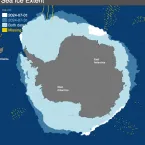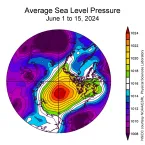Our Research
As climate changes, how do Earth's frozen areas affect our planet and impact society?
In this section
Related News & Stories
Filter by:

Analysis - Sea Ice Today
Arctic sea ice continued the fast retreat that was observed in July through August 10, followed by a brief slowdown, only to pick up pace again. During the first half of August, the ice primarily retreated in the northern Beaufort Sea and in the East Siberian Sea.

Analysis - Ice Sheets Today
The 2024 melt season for the Greenland Ice Sheet is above the 1991 to 2020 average, but the total number of melt days and peak melt area for Greenland are within the midrange of the last 24 years.

Feature Story
From 2007 to 2022, renowned photographer James Balog documented glacial change around the world through a project called the Extreme Ice Survey. One and a half million images showcasing climate change in real time are now stored and managed at the National Snow and Ice Data Center.

Analysis - Sea Ice Today
Arctic sea ice cover retreated rapidly in July 2024, pushing the daily ice extent at the end of the month to the third lowest in the 46-year satellite record.

Spotlight
An exciting new addition has arrived to the NSIDC.org website, allowing users to better explore Indigenous Knowledge and community-based observations of the Arctic.

Analysis - Sea Ice Today
July is the warmest month in the Arctic and hence also the month of peak sea ice loss. As of the middle of July 2024, extent is declining at an above average pace.